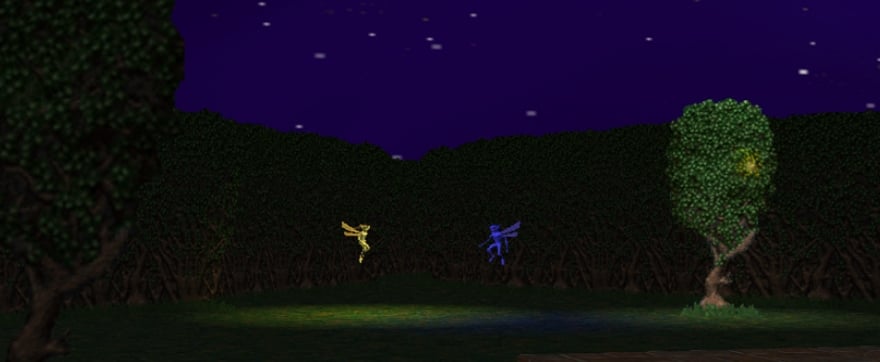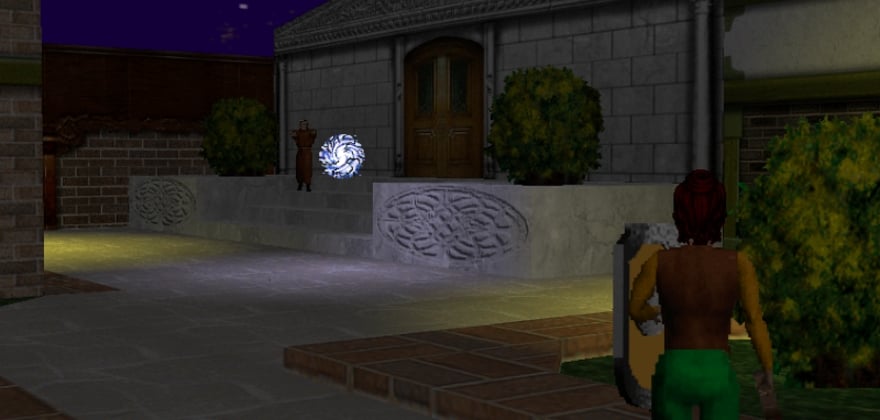
A colony founded through a magical nexus, Meridian 59 had it all going on — until, that is, the portal to the colony collapsed and it was left to fend for itself. Monsters swarmed over the land, politics split the community into factions, and adventurers were called to rise up and become the heroes that were desperately needed. And all it took was $10.95 a month and an internet connection.
Welcome to 1996 and one of the very first graphical MMOs to hit the scene. Meridian 59 may not have been one of the biggest games in the genre, but it was arguably one of the most important, the John Adams to World of Warcraft’s Abraham Lincoln.
While bigger titles have toppled and fallen, Meridian 59 defied the odds to continue to operate even today. This week we’re going to look at this fascinating title and how it helped to pioneer the graphical MMO industry back when the world wide web was still a newfangled toy to the public.
From the maw of Doom
The year was 1978, and the author of this article was a scant two years old with an eyepatch. A programmer named Alan E. Klietz began work on an RPG called Scepter of Goth, a game that would become one of the first in the MUDlike field. Picked up by InterPlay, Scepter charmed players for well over a decade — including brothers Andrew and Chris Kirmse.
Two years apart in age, Andrew and Chris were avid gamers and loved their time with Scepter. As they progressed through college in 1994, the duo talked about how cool it would be to play a graphical version of this game. While this might have been empty talk for most people, these two brothers took the idea seriously and decided to give it a try before real life hit. Despite having virtually nothing to draw upon as reference for the project, the brothers began to build a title that would use a similar graphics engine to the then-popular Doom.
As they progressed through college, this new title — Meridian 59 — was pieced together, bit by bit. Andrew and Chris were thrilled to see their avatars interacting and moving about in the game world, but they knew there was going to be a way to go. They met another set of brothers — Mike and Steve Sellers — who helped to raise funds for the project, which was now under the umbrella of the newly formed Archetype Interactive.
More team members were added to the project by 1995, including Damion Schubert and Rich Vogel. The team pressed on to get Meridian 59 into alpha status by late 1995, at which point the first server was turned on and four curious gamers poked their heads in during a late December evening.
“Meridian 59 was such a trailblazer that we were very excited to have as many people as we had on it because it was the first time anybody had done this and the internet was just kind of getting there then,” Vogel said.
“I think there was some idea what we were doing was special,” Brian “Psychochild” Green noted, “but I don’t believe any of us had [being a pioneer] as an original goal. We just wanted to work on a cool game for the players.”
In fact, Meridian 59 blazed a whole heck of a lot of trails, even if you dismiss its highly debatable claim of being the first true graphical MMORPG. The game was the first internet game from a major publisher, the first time that an MMO got covered in major game magazines, the first graphical MMO to move beyond 2-D, the first MMO to have a flat rate monthly subscription, the first MMO sold in a retail box, the first MMO that was accessible via the internet instead of a service provider, and the first MMO that used the web to handle accounts and deliver a client download.
A whole new world
While Meridian 59 may seem downright primitive compared to what we currently enjoy in MMO gaming, at its launch it was positively futuristic. The graphics engine presented a pseudo-3-D perspective (what most gamers call 2.5-D), similar to titles like Heretic, Duke Nukem 3D, and Doom. There was no jumping, although players could fall down if so desired.
Upon entering the game, players could create a customized human avatar, after which they set out to seek fame and fortune (and probably death). Meridian 59 was skill-based, allowing players to level seven schools of skills independently. Hit points were gained by beating up weaker monsters, and your mana pool could only be expanded by exploring the world to discover special mana nodes.
There were quests to accomplish and factions to join, although PvP quickly became one of the title’s biggest features. Wars were waged over guild halls and servers, and if one player got too out of control, a player justice system could be used to rein him or her in.
“As much as possible, we would have Meridian’s players run the game themselves, as opposed to trying to script out their experience,” Andrew Kirmse said.
Meridian 59 was littered with clever concepts, including in-game email and bulletin boards, guild voting, a chess minigame, guild halls, PvP arena, guild logos, and political appointments. Kirmse said that even emotes were key to bringing the title to life: “The game’s character gestures, such as waving, added a personal feel to an impersonal network.”
Slow and steady…
While Meridian 59’s alpha server could only hold a mere 35 souls, the 1996 beta increased that capacity tremendously. Thousands of testers flooded into the project as word got out, and game company 3DO became interested in investing in the effort. 3DO purchased Archetype Interactive for $5 million in stock in mid-1996, prompting the entire Meridian 59 team to move out to California. Unfortunately, 3DO wasn’t doing so hot by then, and before long the company’s stock was tanking. This resulted in Meridian 59 being prematurely pushed out of the door as the company’s first PC title.
Even though Meridian 59 hatched early, the game’s team worked hard to deliver update after update. The community grew to over 10,000 subscribers even as the Kirmse brothers left the company in 1997. While one could argue that Meridian 59 did its best and had a measure of self-sustainability, it was canceled in 2000 by 3DO (which in turn went belly-up in 2003).
Near Death
While Meridian 59’s fate looked grim in 2000, two former Meridian 59 developers decided that it needed a second chance. Rob “Q” Ellis II (Ultima Online: Third Dawn) and Green formed a new company, Near Death Studios, and secured the rights to relaunch the title. Incidentally, the name of the studio came from the fact that all of the co-founders had extremely close calls while driving.
“I started discussing it with Trip about a year or so before 3DO eventually closed down the US servers,” Ellis later said. “From the start he was supportive of the idea of my running Meridian knowing my love for the game. From there it was just timing and putting things together. I was very lucky to be able to hook up with Psychochild; we were a great complimentary team.”
Near Death Studios didn’t just want to bring back Meridian 59 as it used to be; it wanted to overhaul it for the rapidly advancing MMO genre. As such, the devs worked on installing a new Direct3D-compatible rendering engine in 2004 that took the game’s look from 1995 to something more modern. With dynamic lighting, new visuals, mouselook, and other goodies, Meridian 59 was poised to recapture some of its former glory.
Or it might have, that is, except that another little MMO came along in 2004 that captured such a large market share that little titles like Meridian 59 were left in the dust. Even as it struggled to stay relevant against World of Warcraft and the rest of the field, Meridian 59 did boast a steady community that saw around 2,000 monthly subscriptions in 2005. This was enough to allow Near Death Studios to grow to five full-time employees.
The studio implemented many changes and additions over the years, but the studio’s biggest legacy was refocusing the PvP aspect of the game to become about faction wars. There was even brief talk of a sequel, tentatively titled Kingdom of the Nexus, that would focus on all of the other Meridians in the game’s universe, but this would never amount to much more than just wishful dreams.
Life support
By the end of the decade, Meridian 59 was once again in trouble of extinction. Near Death Studios could no longer afford to remain in operation, as the income from subscribers continued to dwindle and the studio lost its credit card processor. In January 2010, the studio announced that it was closing up shop — although the game, oddly enough, would continue to run.
Meridian 59 was handed back to the Kirmse brothers, who opened it up as a true free-to-play title that currently runs on two US servers. Even more interestingly, the brothers released the source code to the community, allowing players to edit and create new content.
While the game’s lights are still on after a long and somewhat rocky lifespan, Meridian 59 is pretty much a footnote in the MMO industry these days. Its eulogy, such as it is, was written and published by the New Yorker back in 2014.
“Today, almost eighteen years after Meridian 59’s launch, Barloque’s streets are quiet and vacant, its cobblestones buffed and rounded by little more than a digital breeze,” the magazine noted poetically. Still, it couldn’t help but throw in testimonies from fans who cut their teeth on this game and stick by it faithfully two decades later.
 Believe it or not, MMOs did exist prior to World of Warcraft! Every two weeks, The Game Archaeologist looks back at classic online games and their history to learn a thing or two about where the industry came from… and where it might be heading.
Believe it or not, MMOs did exist prior to World of Warcraft! Every two weeks, The Game Archaeologist looks back at classic online games and their history to learn a thing or two about where the industry came from… and where it might be heading.

















